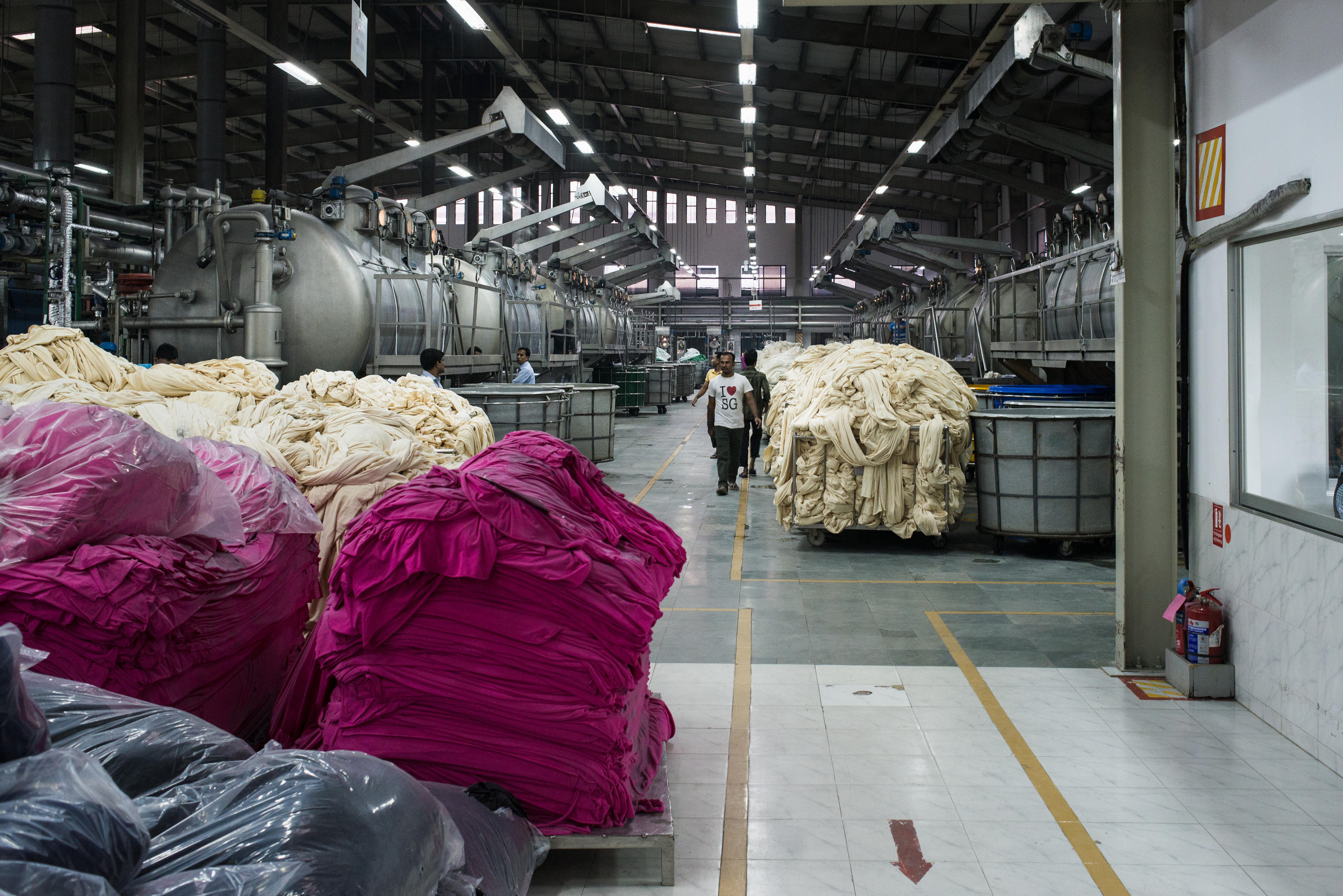Factory hall in Bangladesh
Copyright© Florian Oellers für BMZ
German activities to improve environmental and social standards in the textiles industry Environmental protection and the circular economy
The aim of the circular economy is to extend the lifetime of products and materials and to reuse, repair, refurbish and recycle them so as to reduce the amount of waste generated and the pressure placed on resources.
The textiles industry is still far removed from that aim. Fast fashion has caused worldwide production of fibre-based textiles to almost double over the past twenty years. By 2030 it could rise to 149 million tonnes. The textiles industry is already responsible for a large proportion of global carbon dioxide emissions and water pollution. Material production alone accounts for around 38 per cent of the garment and textiles industry’s greenhouse gas emissions. And yet less than one per cent of textiles in the 27 EU member countries and Switzerland is fibre-to-fibre recycled. Instead, discarded textiles end up in landfill, are incinerated or dumped in water bodies. Each year more than 500 billion US dollars in value is lost because clothing is being under-utilised and not enough textiles are being recycled.
In German development cooperation, the goal is to tackle this problem by partnering with companies in Germany, their suppliers in partner countries and the governments and other players in those countries.
The circular economy in the textiles sector
In the circular economy, textiles waste is recycled as far as possible and processed in a way that allows it to be returned into the production cycle and used once more as a raw material. So establishing a circular economy in the textiles sector is one step towards achieving a just transition, in other words a shift to a more climate-friendly way of living, producing and consuming that is achieved in a socially just way.
Our activities
The BMZ – as part of the German government – is already working together with the EU to establish the circular economy as an important lever in reducing the pressure on resources and protecting the environment. The EU Commission has developed a strategy for achieving a circular economy in the textiles sector, the EU Strategy for Sustainable and Circular Textiles (also known simply as the Textiles Strategy). It encompasses more than 20 planned legislative measures for advancing the circular economy in the textiles sector.
The textiles that come onto the EU market are in future to be more durable, repairable and recyclable. Production is to be more energy-efficient. A digital product passport is to be introduced that will give consumers more information about the textiles they buy. The plan is also to promote the collection, sorting and reuse of textiles so as to reduce textiles waste.
In order to achieve the aims of the EU Textiles Strategy, we are already working with companies and their suppliers on making the necessary changes.
For example, we aim to make the production of textiles more environmentally friendly. With that aim in mind, we are focusing on the various stages of the supply chain and supporting suppliers in achieving higher standards in water and chemicals management or in relation to carbon dioxide emissions.
Together with the members of the Partnership for Sustainable Textiles and their suppliers, we are working on making their collections more suited to a circular economy. That will mean rethinking various stages of the production process. The material chosen for a particular garment, for example, not only determines the garment’s lifetime but also how easy it is to recycle. Separating some blends can be a very complicated process. Also, textiles should in future be designed and put together in such a way that they can be easily taken apart for recycling.
The techniques used for cutting the garment pattern can also be improved. Fabric cutting waste, faulty products or warehouse surpluses have so far been regarded as waste. We are working with companies on using these waste textiles as a resource, recycling them and spinning them once more to make new materials.
A large proportion of textiles disposed of in Germany are exported and sold second-hand in countries like Ghana or Kenya. Many of these imported used clothes are then only used for a short time. Others end up directly in rubbish tips, are incinerated or are disposed of in rivers or oceans. Often, the countries importing the textiles waste do not have the infrastructure needed to process or recycle it. Our aim is to work with the private sector and other players in these countries to find ways of using the textiles waste as a resource.
Through special programmes with the private sector, particularly suppliers in partner countries that are producing for our companies, we can introduce innovative practices that are better for the environment and increasingly utilise old clothes and textiles as a resource, in line with the principles of the circular economy.
As at: 27/06/2024
